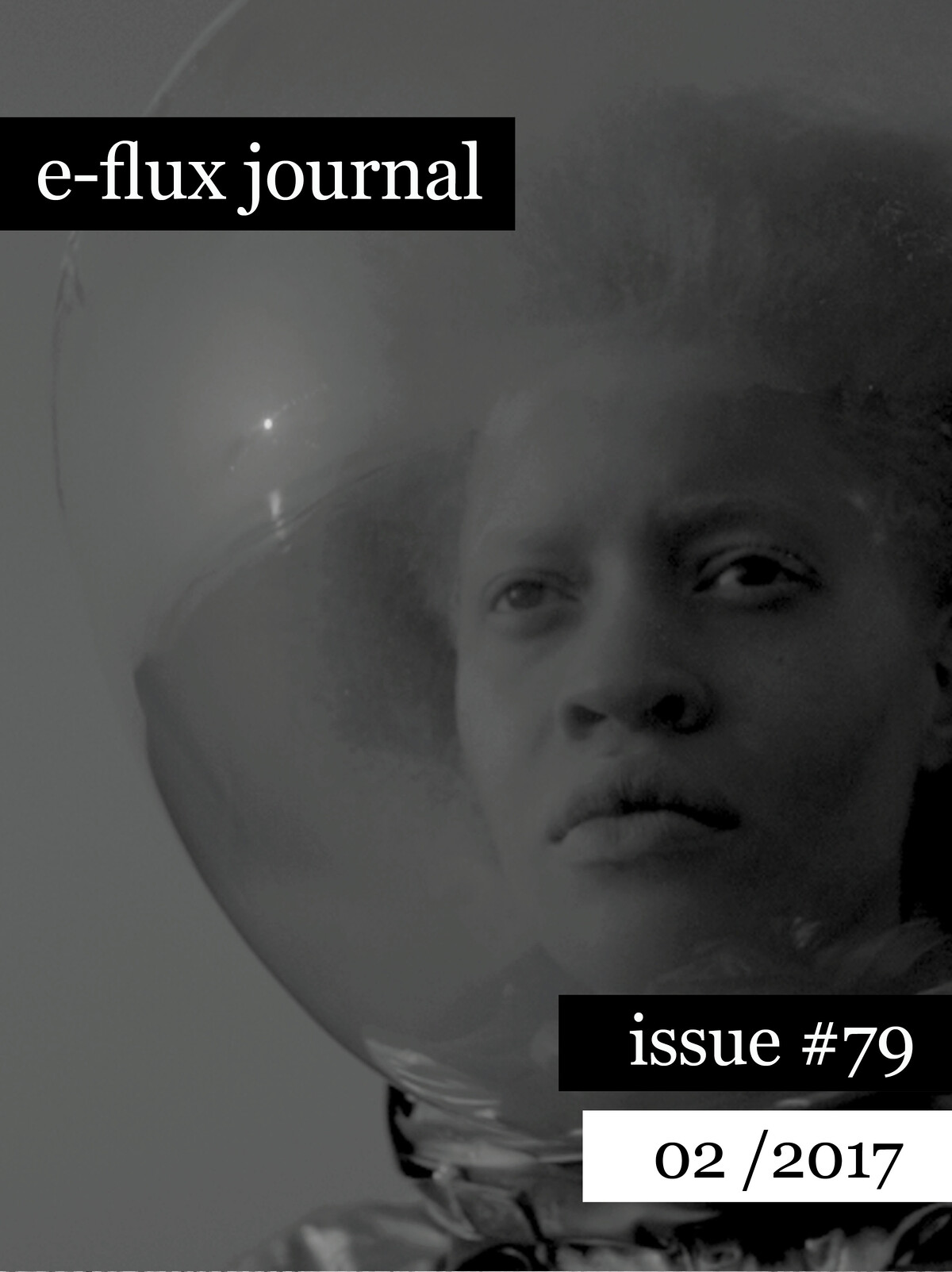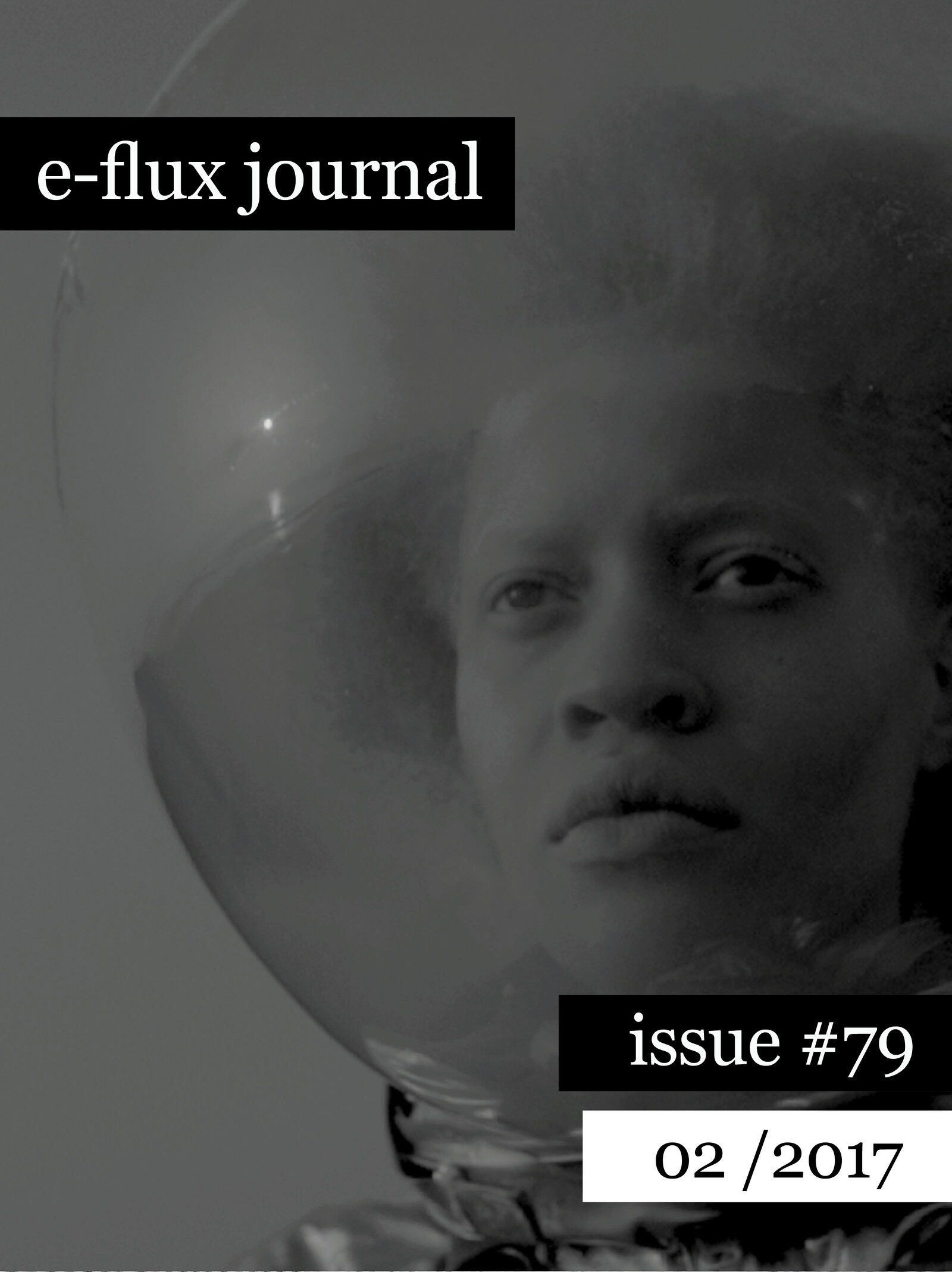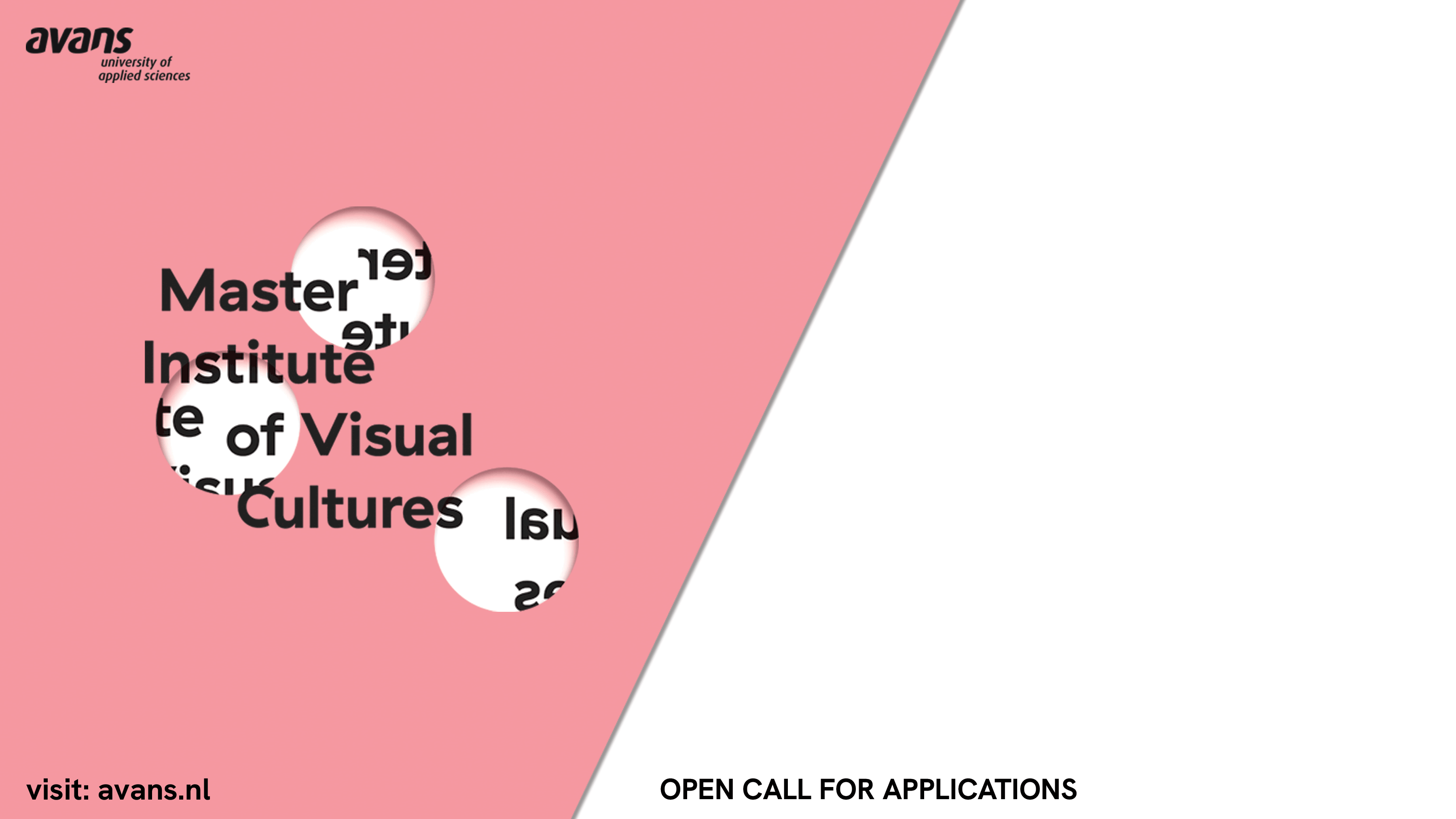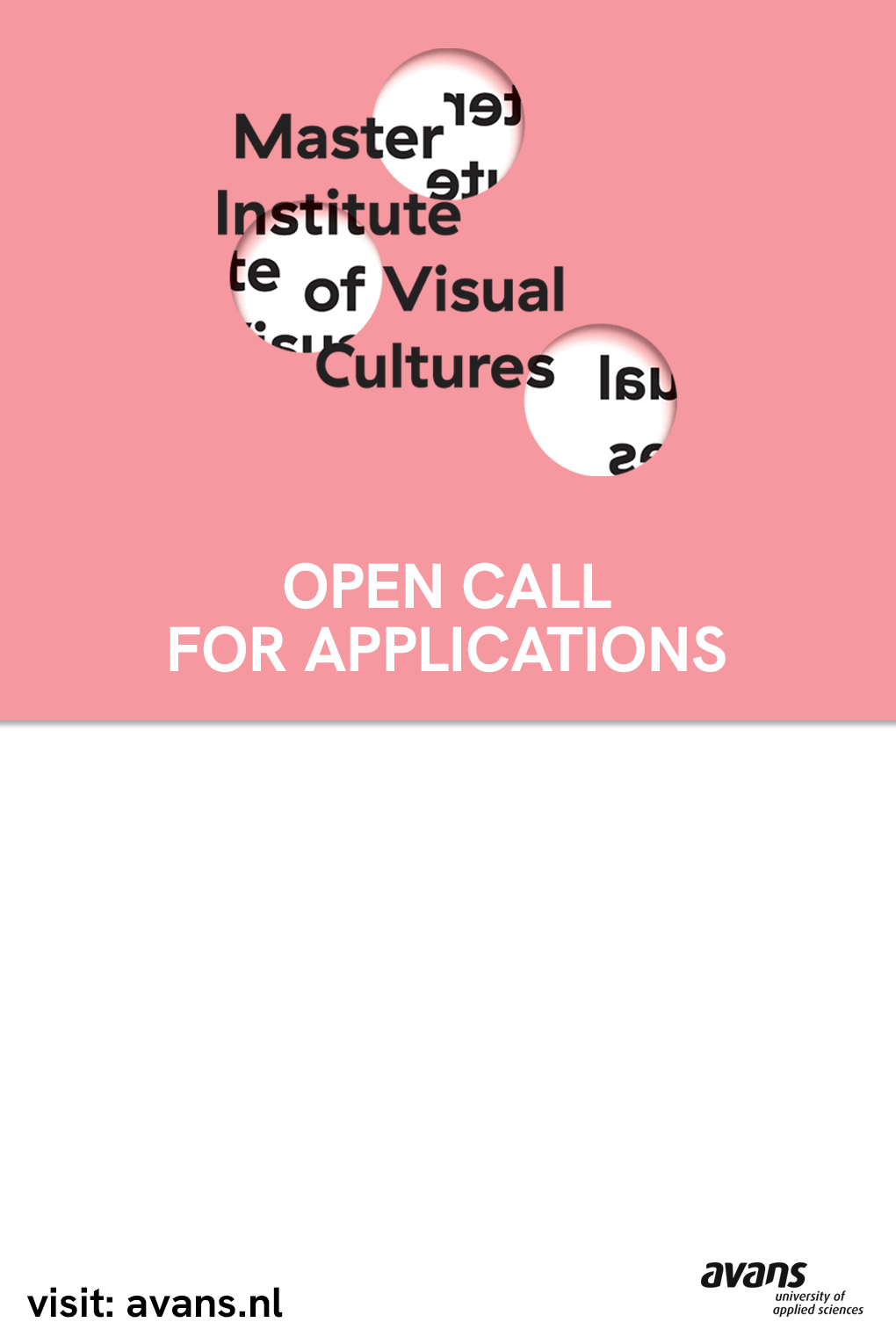guest-edited by Gean Moreno
with David Marriott, Denise Ferreira da Silva, Jared Sexton, Sampada Aranke, Lamin Fofana, Patrick King, James Boggs, Nicholas Mirzoeff, and Adam Pendleton
So this is the plan that we came up with in the huddle, stunned and not so stunned at the storm clouds that have broken, at the deluge that is here: we are putting up alternative facts to the alternative facts that are being deployed in a rightward swerve that has us up against the rails. We are also putting up an alternative common sense to the centrist liberal one that is what ultimately, at the fundamental level, keeps this world from coming undone, preservation being its constitutive mandate. “Let us imagine,” David Marriott begins his essay in this issue, “that ‘black lives matter’ is a scandalous, even decadent claim, characterized, as the definition has it, by excess or luxury.” If this is so, Marriott makes clear, it is an excess we cannot afford to not afford. It is evident that #BlackLivesMatter and the organizations that coalesce the Movement for Black Lives (M4BL) represent the most important and promising developments in the theory and practice of abolition. The luxury it is bound to may be communal above all else.
Unwinding fantasies of a post-racial society, the movement has rerouted political conversations and reignited imaginations. But we should bear in mind—keeping the alternative facts at bay—that this is happening through pelted riot shields and clogged circulation illuminated by the light of a blazing CVS store. And also, as Jared Sexton points out, through “the independent generation of a vast digital archive, a prolific online social-media commentary, and a rich analogue protest culture involving political graffiti, fashion, and dance, among other things.” Ferguson, as artist Carl Pope would probably put it, was and it ain’t: the future is its real name. It is what is happening, at all times and on all frequencies, as long as the desire to disorganize this world, to mangle it into something radically unlike itself, continues to burn. This is what is exemplary: the scorch-trail that the new insurrectionary bodies have put through everything, and which in turn is beginning to texture our moment away from the homogenous continuum of a resilient neoliberal and anti-black status quo, despite the desperate efforts to retrench it with executive orders and crony appointments.
The mandate we face is a new articulation of race and its role in reproducing class society. Or perhaps it’s the reverse: a new account of class and its role in reproducing racist society. Certainly the whole thing is gendered. The whole thing is increasingly difficult to disentangle from a mutating earth system, too. The whole thing is rotten. Everything must be considered, especially what lies beyond the world as it is currently assembled and the institutional practices holding it together. It is important to record this rethinking, to report back, to circulate the material, and build the archive. History teaches that neither reform nor revolution is possible without revolutionary theory.
The mass media knows this too, and it has hostilely presented M4BL in general and BLM in particular in ways that simplify its ideas, downplay its organizational capacity, shade over its intersectional potency, and demonize the young black bodies whose availability to unaccountable state violence is the oldest and most consistent American reality since the European invasion. It certainly predates the republic, such as it is, and as of this writing, it may outlast it, now that a(nother) white supremacist has been elected. In light of such distorting narratives, it is important to provide a more robust, dynamic, and truthful image of this new activism through a partisan but critical lens. It seems necessary to place this current revolutionary sequence and its ensembles within a larger landscape of radical thinking, to highlight the bonds that exist in the crawlspaces of the common project.
—Julieta Aranda, Brian Kuan Wood, Gean Moreno, Stephen Squibb, and Anton Vidokle
In this issue:
David Marriott—On Decadence: Bling Bling
If the virtues of restraint, industriousness, thriftiness have tended to be characterized as white, blackness is often construed as a desiring in whose meaning excess, or luxury, signifies a sociocultural impoverishment that is morally bankrupt. This trope takes on the amplitude of an all-encompassing theme in the discourse of anti-blackness in the West. It compels a view of blackness that, in relation to sovereign life, reveals an experience of excess enjoyed beyond consummation and one that is socially irresponsible. So what of this extravagant expenditure itself? If claiming “black lives matter” is to risk a certain exorbitance, this is not because there is any certainty about the meaning of black life, but because asserting that black life matters foregrounds those attributes by which blackness is assumed to have a value in culture. Black is a being that is somehow both useless and endlessly driven by consummation: bling bling.
Denise Ferreira da Silva—1 (life) ÷ 0 (blackness) = ∞ − ∞ or ∞ / ∞: On Matter Beyond the Equation of Value
Both the anthropological and sociological versions of racial knowledge transform the consequences of hundreds of years of colonial expropriation into the effects of efficient causes (the laws of nature) as they operate through human forms (bodies and societies). In sum, as a category of racial difference, blackness occludes the total violence necessary for this expropriation, a violence that was authorized by modern juridical forms—namely, colonial domination (conquest, displacement, and settlement) and property (enslavement). Nevertheless, blackness—precisely because of how, as an object of knowledge, it occludes these juridical modalities—has the capacity to unsettle the ethical program governed by determinacy, through exposing the violence that the latter refigures.
Jared Sexton—All Black Everything
Mixture as power: but how? Black is what you get when all the primary colors are present equally in the mix. It is what you get when there is equality among colors. In other words, “the endless sequence of possible syntheses of yellow, red, and blue manifested in constantly varying forms” are, in a way, the infinite shades of blackness that Moten has in mind when he claims that Mondrian’s “great, final picture, Victory Boogie Woogie, is all black, is all of what had been absorbed in black, is the explication of a dissonant, chromatic saturation, the inhabitation of a break or border, the disruption embedded in the grid’s boundaries.”
Sampada Aranke—Material Matters: Black Radical Aesthetics and the Limits of Visibility
By emphasizing abstract and conceptual artistic practices, my definition of black radical aesthetics builds upon the notion of blackness as an originary abstraction—a category created in the service of devastating material, corporeal, and psychological violences that trafficked through the Middle Passage and whose afterlives are still active today. Abstract and conceptual practices do not abandon the social, cultural, and material meanings that blackness invokes. As Adrienne Edwards has lucidly noted, these practices turn to what blackness “does in the world without conflating it—and those who understand blackness from within a system that deems them black, that is black people—with a singular historical narrative or monolithic subjectivity.”
Lamin Fofana—Dis/Continuum
The bonds that new modes of resistance establish with previous historical sequences are scratching loose their very own world-disorganizing potential. Constituent history has never submitted to the tyranny of the textual. The sonic moves audiences-cum-comrades, fleshy things that, in feeling and moving communally, call up the specter of the common project. This is the surplus of their corporeal, anti-transactional transactions. Of their uprising against even minor miseries. Whether one is thinking of music, spoken word, coded patois, scratched records, effective and affective oration, glitching at mechanical interfaces, the multidimensions of performativity in and around sounds—the sonic has always been a most active field in bonds-making. A kind of goddammed Mississippi, seeded with tragedy and resilience, to the frigid Northeast of more buttoned-up organic intellectuals who prefer the tabloid and the blog. Approaching the vicinity of this fact—or perhaps the ways in which its incontrovertibility impinged in our catching-up thinking—led us to commission e-flux journal’s first “text” as track. Of course, “track” seems wanting as a name for the landscape that Lamin Fofana came back with. What we got, what we are still getting, as the thing unspools its textured strands, is our increasingly derelict Now, compressed and distilled, the good shards extracted from it, into a flexible terrain that flickers in and out of different configurations. At one moment, it is riot-space; at another, thinking-space; at yet another, chill-out-and-recharge-space; and at yet another, historical-space. At all times it is a delicate synthesis of multifarious strands and an enterprise in gauging dirt patches in this mad moment, in exposing little bits of hard ground on which our desires for another world, certainly for the end of this one, can continue to find traction.
Patrick King—Introduction to Boggs
At a very basic level, Boggs was trying to answer the question: “What has happened within the working class since Marx?” The proletariat, in Boggs’s view, could no longer be grasped as a “homogeneous segregated bloc.” Capitalist development in the US had engendered “changes in the nature of work, the social composition of various strata of the population, the classes within it, and the culture of the population.” The subaltern stratum of the outsiders—a product of a renewed capitalist class offensive and racialized strategies of social control in the US—possessed a class position that transcended the limits of bourgeois political reform and posed an antagonistic challenge to the wage-labor system. More to the point, the outsiders could potentially combine heterogeneous forces of social protest into a universal movement.
James Boggs—Black Power: A Scientific Concept Whose Time Has Come
Those progressives who are honestly confused by the concept of Black Power are in this state of confusion because they have not scientifically evaluated the present stage of historical development in relation to the stage of historical development when Marx projected the concept of workers’ power vs. capitalist power. Yesterday the concept of workers’ power expressed the revolutionary social force of the working class organized inside the process of capitalist production. Today the concept of Black Power expresses the new revolutionary social force of the black population concentrated in the black belt of the South and in the urban ghettos of the North—a revolutionary social force which must struggle not only against the capitalists but against the workers and middle classes who benefit by and support the system which has oppressed and exploited blacks.
Nicholas Mirzoeff—Below the Water: Black Lives Matter and Revolutionary Time
“Life” in the phrase “Black Lives Matter” is defined as that which can be killed or which dies. It is also a measure of time, for however long we are alive is a life. Many human lives have been and are considered disposable, surplus, or without value, so the movement speaks of each life as mattering. When black life matters, time itself is altered, creating revolutionary time. These temporalities have become entangled with the crisis of earth-system time known as the Anthropocene. That time, known to geologists as “deep time,” is in crisis. And it’s a good thing too, because out of that crisis has reemerged the possibility of revolutionary time. No one has been more aware of this dynamic than the anti-black reactionary right. To be for revolutionary time, whatever one’s own personal history, is to be for anti-anti-blackness as the condition of transformative possibility.
Adam Pendleton—Just Back from Los Angeles: A Portrait of Yvonne Rainer
Adam Pendleton’s Just Back From Los Angeles: A Portrait of Yvonne Rainer is the third in a series of video portraits, following My Education: A Portrait of David Hilliard, the former chief of staff for the Black Panthers, and Lorraine O’Grady: A Portrait. This text represents a transcription of the script Pendleton prepared for Rainer to read during their day spent filming at the Ridgeway Diner in Chelsea. The text mixes citations from Stokely Carmichael, Malcom X, Keeanga-Yamahtta Taylor, and excerpts from Rainer’s own published works; the film ends with the gospel song “I Am Saved” by the Silver Harpes over the footage of Rainer’s now canonical movement work Trio A. Whether read or viewed, Just Back from Los Angeles is an uncanny work, one that deploys the double meaning of the word “movement”—now choreography, now social uprising—to reveal a shared method of freedom coursing beneath traditions typically received separately.
Further material related to this issue will be published on e-flux conversations. Stay tuned.
The print edition of e-flux journal can be found at:
Amsterdam: De Appel arts centre / Rijksakademie van beeldende kunsten Andratx: CCA Andratx Antwerp: M HKA Museum van Hedendaagse Kunst Århus: Kunsthal Aarhus Athens: OMMU Auckland: split/fountain Austin: Arthouse at the Jones Center Baden-Baden: Staatliche Kunsthalle Baden-Baden Banff: Walter Phillips Gallery, The Banff Centre Barcelona: Arts Santa Mònica / MACBA Basel: Kunsthalle Basel / Museum für Gegenwartskunst Basel Beijing and Guangzhou: Vitamin Creative Space Beirut: 98weeks Belgrade: Cultural Center of Belgrade Bergen: Bergen Kunsthall / Rakett Berlin: b_books / Berliner Künstlerprogramm – DAAD / Bücherbogen am Savignyplatz GmbH / Books People Places / do you read me? / Haus der Kulturen der Welt / Motto / Neuer Berliner Kunstverein (n.b.k.) / Pro qm Belfast: Platform Arts Bern: Kunsthalle Bern / Lehrerzimmer Bialystok: Arsenal Gallery Bielefeld: Bielefelder Kunstverein Biella: UNIDEE - University of Ideas, Cittadellarte - Fondazione Pistoletto Onlus Birmingham: Eastside Projects / Ikon Gallery Bologna: MAMbo – Museo d’Arte Moderna di Bologna Bregenz: Kunsthaus Bregenz Bristol: Arnolfini Brussels: WIELS Contemporary Art Centre Bucharest: National Museum of Contemporary Art Bucharest (MNAC) / Pavilion Unicredit Cairo: Beirut / Contemporary Image Collective (CIC) / Townhouse Gallery Calgary: The New Gallery Cambridge: Wysing Arts Center Castello: Espai d´art contemporani de Castelló (EACC) Chicago: Graham Foundation / Reva and David Logan Center for the Arts / The Renaissance Society at The University of Chicago Cologne: Kölnischer Kunstverein Copenhagen: Overgaden Derry: CCA Derry~Londonderry Dijon: Les Ateliers Vortex Dublin: Dublin City Gallery The Hugh Lane / Project Arts Centre Dusseldorf: Kunstverein für die Rheinlande und Westfalen Eindhoven: Van Abbemuseum Frankfurt: Städelschule / Portikus Gdansk: Łaźnia Centre For Contemporary Art Geneva: Centre de la photographie Ghent: S.M.A.K. Glasgow: CCA Centre for Contemporary Arts / Glasgow Sculpture Studios Graz: Grazer Kunstverein / IZK Institute for Contemporary Art, TU Graz / Kunsthaus Graz / Künstlerhaus KM– / para_SITE Gallery / Grijon: LABoral Centre for Art and Creative Industries Groningen: University of Groningen Hamburg: Kunstverein in Hamburg Helsinki: Museum of Contemporary Art Kiasma Hobart: CAST Gallery / INFLIGHT Hong Kong: Asia Art Archive Iași: theartstudent at the University of Fine Arts, Iași Innsbruck: Galerie im Taxispalais Istanbul: BAS / DEPO / Galeri Zilberman / SALT Johannesburg: Center for Historical Reenactments Kansas City: La Cucaracha Press Klagenfurt: Kunstraum Lakeside Kristiansand: SKMU Sørlandets Kunstmuseum Kyiv: Visual Culture Research Center Leeds: Pavilion Lisbon: Maumaus, Escola de Artes Visuais / Oporto / Kunsthalle Lissabon Ljubljana: Moderna galerija Llandudno: MOSTYN London: Architectural Association—Bedford Press / Calvert 22 / Chisenhale Gallery / Gasworks / ICA / Serpentine Gallery / The Showroom / Visiting Arts Los Angeles: REDCAT Loughborough: Radar, Loughborough University Luxembourg: Casino Luxembourg Madrid: Brumaria / CA2M / PENSART Maastricht: Jan van Eyck Academie Marfa: Ballroom Marfa Melbourne: Monash University Museum of Art (MUMA) / World Food Books Merrylands: Cerdon College Mexico City: Librería Casa Bosques / Proyectos Monclova Milan: Fondazione Nicola Trussardi / HangarBicocca Milton Keynes: MK Gallery Minneapolis: Walker Art Center Monaco: Nouveau Musée National de Monaco Moncton: Fixed Cog Hero (a bicycle courier company) Montreal: Canadian Centre for Architecture (CCA) Moscow: Garage Center for Contemporary Culture Munich: Haus der Kunst / Museum Villa Stuck / Walther Koenig Bookshop New Delhi: Sarai CSDS New York: e-flux / Independent Curators International (ICI) / Printed Matter, Inc / McNally Jackson Nottingham: Nottingham Contemporary North Little Rock: Good Weather Gallery Omaha: Bemis Center for Contemporary Arts Oslo: Kunstnernes hus Oxford: Modern Art Oxford Padona: Fondazione March Per L’Arte Contemporanea Paris: castillo/corrales – Section 7 Books / Centre Pompidou / Les Laboratoires d’Aubervilliers Philadelphia: Bodega Pori: Pori Art Museum Portland: Portland Institute for Contemporary Art (PICA) / Publication Studio Porto: Museu de Arte Contemporânea de Serralves Prague: DOX Centre for Contemporary Art Prishtina: Stacion – Center for Contemporary Art Prishtina Providence: AS220 Reykjavik: Reykjavik Art Museum Riga: kim? Rio de Janeiro: Capacete / A Gentil Carioca Rome: MACRO Museo d’Arte Contemporanea Roma / Opera Rebis Rotterdam: Piet Zwart Institute / Witte de With | Center for Contemporary Art Saint-Nazaire: Le Grand Cafe, centre d’art contemporain Salzburg: Salzburger Kunstverein San Antonio: Artpace San Sebastián: Centro Internacional Cultura Contemporanea São Paulo: KUNSTHALLE São Paulo / Master in Visual Arts, Faculdade Santa Marcelina Sarajevo: Sarajevo Center for Contemporary Art (SCCA) Seoul: The Books / The Book Society Sherbrooke: Foreman Art Gallery of Bishop’s University Singapore: The Ngee Ann Kongsi Library Skopje: Press to Exit Project Space Sofia: ICA-Sofia / Sofia Art Gallery / SWIMMING POOL St Erme Outre et Ramecourt: Performing Arts Forum St Louis: White Flag Projects Stockholm: Bonniers Konsthall / Iaspis / Index - The Swedish Contemporary Art Foundation / Konstfack, University College of Art, Craft and Design / Konsthall C / Tensta konsthall Stuttgart: Württembergischer Kunstverein Stuttgart Tallinn: Kumu Art Museum of Estonia The Hague: Stroom Den Haag Toronto: Art Metropole / Mercer Union / The Power Plant Torun: Centre of Contemporary Art Znaki Czasu in Torun (CoCA) Toowoomba: Raygun Contemporary Art Projects Trieste: Trieste Contemporanea Trondheim: NTNU University Library Umeå: Bildmuseet, Umeå University Utrecht: BAK, basis voor actuele kunst / Casco – Office for Art, Design and Theory Vaduz: Kunstmuseum Liechtenstein Valencia: IVAM–Biblioteca Valletta: Malta Contemporary Art Foundation Vancouver: Artspeak / Fillip—Motto / Morris and Helen Belkin Art Gallery, University of British Columbia / READ Books, Charles H. Scott Gallery, Emily Carr University of Art and Design Venice: The Biennale Library-ASAC Vienna: Kunsthalle Wien / Salon für Kunstbuch—21er Haus Vigo: MARCO, Museo de Arte Contemporanea de Vigo Vilnius: Contemporary Art Centre (CAC) Vitoria-Gasteiz: Centro Cultural Montehermoso Kulturunea Visby: BAC – Baltic Art Center Warsaw: Zachęta National Gallery of Art Wiesbaden: Nassauischer Kunstverein (NKV) Yerevan: Armenian Center For Contemporary Experimental Art (NPAK) Zagreb: Galerija Miroslav Kraljevic / Gallery Nova / DeLVe | Institute for Duration, Location and Variables Zurich: Postgraduate Program in Curating, Zürich University of the Arts / Shedhalle / White Space



